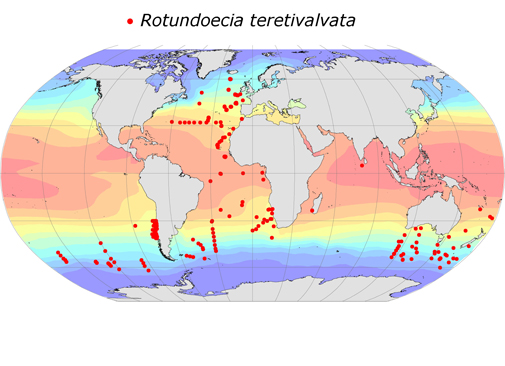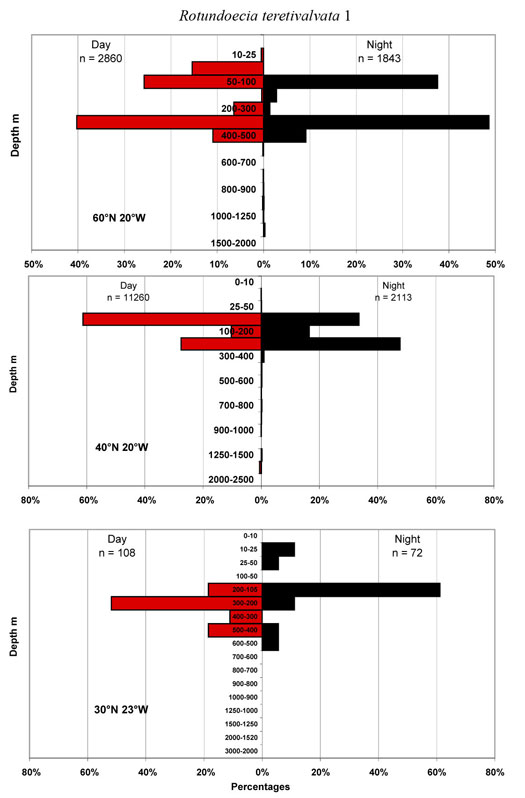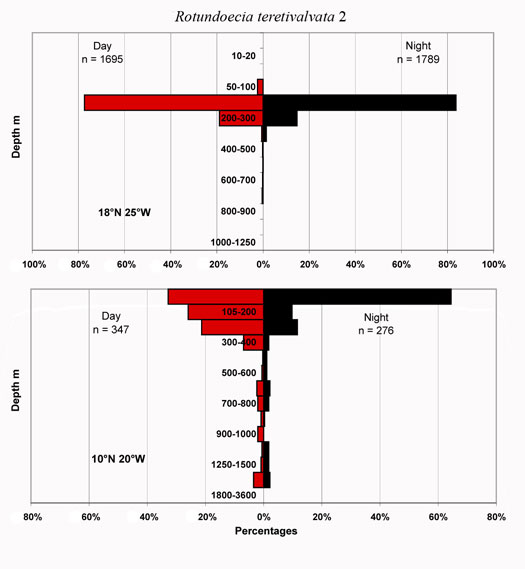Atlas of Atlantic Ostracods
Taxon details
Rotundoecia teretivalvata (Iles. 1953)
- Order:
- MYODOCOPA
- Suborder:
- Halocypridina
- Family:
- Halocyprididae
- Subfamily:
- Conchoecinae
- Size range (females):
- 0.7-0.9 mm
- Size range (males):
- 0.8-0.9 mm
- Depth:
- epi-/mesopelagic
Notes
481 records
When Müller (1891) first described Conchoecia rotundata from the Mediterranean, he noted there were two size forms, one long the other short. Iles (1953) in his preliminary (and only) report on halocyprids of the Benguela Current region split off the short form, naming it Conchoecia teretivalvata. When Gooday (1981) revised what he termed the ‘skogsbergi.’ complex, he concluded that both Iles’s species and another short form were present. The latter species resembled Müller’s original description of the short form C. rotundata, and so he concluded that both species are valid. Poulsen (1973) placed all Muller’s ‘rotundata. group’ species in the genus But soon as the numbers of species in this genus grew larger, it became apparent that this assemblage of species was extremely heterogeneous. Chavtur and Angel (in press) are revising the genus and are assigning this species to a new monospecific genus Rotundoecia.
Its known latitudinal range is 62°S to 60°N and its bathymetric range is shallow mesopelagic from 50-500m. The geographical distribution shown in the map is clearly anomalous. The species appears to be almost totally absent from the Indian Ocean, including the Indian Ocean sector of the Southern Ocean, and has not been recorded from the North and Central Pacific. It also appears to be rare in the oligotrophic gyres in the Atlantic. Its bathymetric profiles show that it is predominantly a shallow mesopelagic species that is restricted in its vertical range by the seasonal thermocline. It has been taken at depths down to 2000m, but with such small species these deeper records may be the result from leakage into the closed net as it passes through the shallower depths at which the species is abundant. Re-examination of Iles’s material from the region of the Benguela Current, includes a few specimens that are >1mm. Deevey (1974) also records a large form of this species in the South Atlantic, and it seems likely that these large forms may be a new, albeit closely related, species.
| Equator | N | Mean mm | s.d. | Range mm |
|---|---|---|---|---|
| Female | 18 | 0.83 | 0.021 | 0.78-0.86 |
| Male | 20 | 0.81 | 0.018 | 0.78-0.84 |
| A-1 | 27 | 0.65 | 0.024 | 0.60-0.70 |
| Azores Front | N | Mean mm | s.d. | Range mm |
|---|---|---|---|---|
| Female | 9 | 0.79 | 0.028 | 0.76-0.86 |
| Male | 9 | 0.80 | 0.023 | 0.76-0.84 |
| A-1 | 8 | 0.63 | 0.022 | 0.58-0.66 |
| A-2 |
| 44°N | n | Mean mm | s.d. | Range mm |
|---|---|---|---|---|
| Female | 81 | 0.81 | 0.040 | 0.74-0.92 |
| Male | 56 | 0.81 | 0.025 | 0.76-0.86 |
| A-1 | 137 | 0.64 | 0.025 | 0.58-0.70 |
| A-2 |






